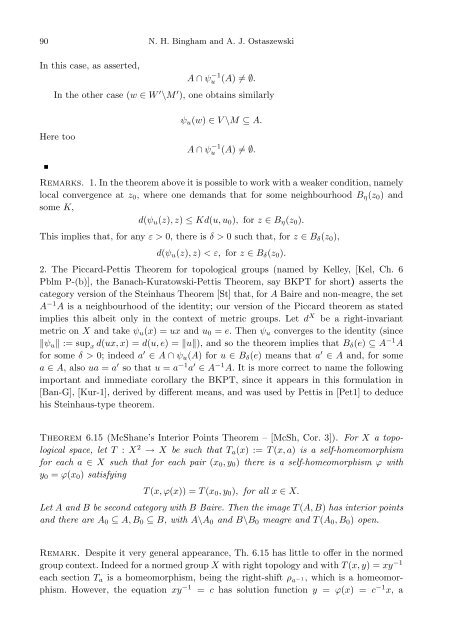Normed versus topological groups: Dichotomy and duality
Normed versus topological groups: Dichotomy and duality
Normed versus topological groups: Dichotomy and duality
Create successful ePaper yourself
Turn your PDF publications into a flip-book with our unique Google optimized e-Paper software.
90 N. H. Bingham <strong>and</strong> A. J. OstaszewskiIn this case, as asserted,A ∩ ψ −1u (A) ≠ ∅.In the other case (w ∈ W ′ \M ′ ), one obtains similarlyHere tooψ u (w) ∈ V \M ⊆ A.A ∩ ψ −1u (A) ≠ ∅.Remarks. 1. In the theorem above it is possible to work with a weaker condition, namelylocal convergence at z 0 , where one dem<strong>and</strong>s that for some neighbourhood B η (z 0 ) <strong>and</strong>some K,d(ψ u (z), z) ≤ Kd(u, u 0 ), for z ∈ B η (z 0 ).This implies that, for any ε > 0, there is δ > 0 such that, for z ∈ B δ (z 0 ),d(ψ u (z), z) < ε, for z ∈ B δ (z 0 ).2. The Piccard-Pettis Theorem for <strong>topological</strong> <strong>groups</strong> (named by Kelley, [Kel, Ch. 6Pblm P-(b)], the Banach-Kuratowski-Pettis Theorem, say BKPT for short) asserts thecategory version of the Steinhaus Theorem [St] that, for A Baire <strong>and</strong> non-meagre, the setA −1 A is a neighbourhood of the identity; our version of the Piccard theorem as statedimplies this albeit only in the context of metric <strong>groups</strong>. Let d X be a right-invariantmetric on X <strong>and</strong> take ψ u (x) = ux <strong>and</strong> u 0 = e. Then ψ u converges to the identity (since‖ψ u ‖ := sup x d(ux, x) = d(u, e) = ‖u‖), <strong>and</strong> so the theorem implies that B δ (e) ⊆ A −1 Afor some δ > 0; indeed a ′ ∈ A ∩ ψ u (A) for u ∈ B δ (e) means that a ′ ∈ A <strong>and</strong>, for somea ∈ A, also ua = a ′ so that u = a −1 a ′ ∈ A −1 A. It is more correct to name the followingimportant <strong>and</strong> immediate corollary the BKPT, since it appears in this formulation in[Ban-G], [Kur-1], derived by different means, <strong>and</strong> was used by Pettis in [Pet1] to deducehis Steinhaus-type theorem.Theorem 6.15 (McShane’s Interior Points Theorem – [McSh, Cor. 3]). For X a <strong>topological</strong>space, let T : X 2 → X be such that T a (x) := T (x, a) is a self-homeomorphismfor each a ∈ X such that for each pair (x 0 , y 0 ) there is a self-homeomorphism ϕ withy 0 = ϕ(x 0 ) satisfyingT (x, ϕ(x)) = T (x 0 , y 0 ), for all x ∈ X.Let A <strong>and</strong> B be second category with B Baire. Then the image T (A, B) has interior points<strong>and</strong> there are A 0 ⊆ A, B 0 ⊆ B, with A\A 0 <strong>and</strong> B\B 0 meagre <strong>and</strong> T (A 0 , B 0 ) open.Remark. Despite it very general appearance, Th. 6.15 has little to offer in the normedgroup context. Indeed for a normed group X with right topology <strong>and</strong> with T (x, y) = xy −1each section T a is a homeomorphism, being the right-shift ρ a −1, which is a homeomorphism.However, the equation xy −1 = c has solution function y = ϕ(x) = c −1 x, a
















